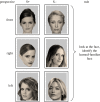Sheep recognize familiar and unfamiliar human faces from two-dimensional images
- PMID: 29291109
- PMCID: PMC5717684
- DOI: 10.1098/rsos.171228
Sheep recognize familiar and unfamiliar human faces from two-dimensional images
Abstract
One of the most important human social skills is the ability to recognize faces. Humans recognize familiar faces easily, and can learn to identify unfamiliar faces from repeatedly presented images. Sheep are social animals that can recognize other sheep as well as familiar humans. Little is known, however, about their holistic face-processing abilities. In this study, we trained eight sheep (Ovis aries) to recognize the faces of four celebrities from photographic portraits displayed on computer screens. After training, the sheep chose the 'learned-familiar' faces rather than the unfamiliar faces significantly above chance. We then tested whether the sheep could recognize the four celebrity faces if they were presented in different perspectives. This ability has previously been shown only in humans. Sheep successfully recognized the four celebrity faces from tilted images. Interestingly, there was a drop in performance with the tilted images (from 79.22 ± 7.5% to 66.5 ± 4.1%) of a magnitude similar to that seen when humans perform this task. Finally, we asked whether sheep could recognize a very familiar handler from photographs. Sheep identified the handler in 71.8 ± 2.3% of the trials without pretraining. Together these data show that sheep have advanced face-recognition abilities, comparable with those of humans and non-human primates.
Keywords: cognitive testing; learning; sheep.
Conflict of interest statement
The authors declare no conflict of interests.
Figures





Comment in
-
Response to 'Sheep recognize familiar and unfamiliar human faces from two-dimensional images'.R Soc Open Sci. 2019 May 29;6(5):182187. doi: 10.1098/rsos.182187. eCollection 2019 May. R Soc Open Sci. 2019. PMID: 31218041 Free PMC article. No abstract available.
References
-
- Liu J, Harris A, Kanwisher N. 2002. Stages of processing in face perception: an MEG study. Nat. Neurosci. 5, 910–916. (doi:10.1038/nn909) - DOI - PubMed
-
- Tanaka JW, Farah MJ. 1993. Parts and wholes in face recognition. Q. J. Exp. Psychol. 46, 225–245. (doi:10.1080/14640749308401045) - DOI - PubMed
-
- Haxby JV, Hoffman EA, Gobbini MI. 2002. Human neural systems for face recognition and social communication. Biol. Psychiatry 51, 59–67. (doi:10.1016/S0006-3223(01)01330-0) - DOI - PubMed
-
- Hancock PJB, Bruce V, Burton AM. 2000. Recognition of unfamiliar faces. Trends Cogn. Sci. 4, 330–337. (doi:10.1016/S1364-6613(00)01519-9) - DOI - PubMed
-
- Johnston RA, Edmonds AJ. 2009. Familiar and unfamiliar face recognition: a review. Memory 17, 577–596. (doi:10.1080/09658210902976969) - DOI - PubMed
Associated data
LinkOut - more resources
Full Text Sources
Other Literature Sources
Molecular Biology Databases

